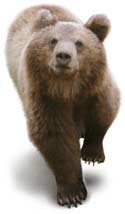Distribution:
Brown bear (Ursus arctos) range in Greece comprises two distinct nuclei located in Pindos range (total surface of continuous range 6,200 km2) and Rhodope mountain complex (total surface of continuous range 2,400 km2). Pindos distribution nucleus is the southernmost range of the species in Europe reaching almost the 39o parallel.
Recent data (1988 – 2002) show trends of southwards expansion of brown bear range in Pindos nucleus. Bear presence has also been recorded on a permanent basis since 1985 on Voras (Kaimakchalan) Mountain.
Data for the period 1988-1995 give a more detailed map showing the frequency of brown bear presence within the total range. See map illustrating:
- Regular presence (reproduction of species in a continuous and regular basis – e.g. every 1-2 years).
- Sporadic or non regular presence (reproduction of species is sporadic, e.g. every 3-4 years, mainly solitary or dispersed animals from source areas occupy the area)
- Area/ areas with re-colonization by species (approximate starting period of re-colonization procedure must be defined).
For the most recent data on the distribution of large carnivores in Europe you can visit the website of EU, where you can find in pdf format the brochure of IEA/LCIE, for the research of which Callisto has also contributed.
You can also visit the official online database for the status of the 5 carnivore species in Europe and the Balkans, which comprises the result of IEA/LCIE project, in which Callisto had the responsibility for the Balkans.
Population fragmentation
In the western bear population nucleus, a serious risk of internal fragmentation at two points of the species range:
- in the area nearby the town of Kastoria
-
in the area of Mt. Askion
In the eastern population nucleus a risk of internal range fragmentation occurs nearby the area of Nevrokopi (see distribution map).
. 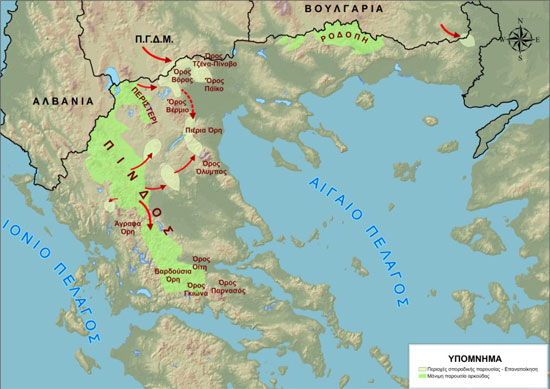
Population status:
Population estimates in numbers of animals and/or reproduction units.
Levels and trends: Actual brown bear minimum population size in Greece is estimated at 130-160 individuals (females with cubs spring surveys method). In Pindos range population is estimated at 115-145 individuals whereas in Rhodope it reaches 20-25 individuals. For the period since 1985 –1999 bear population in Greece shows locally increasing trends especially in the western distribution nucleus (Pindos range).
Mortality: For the period 1985–1990, known cases of average human-caused bear mortality affects 11.6% - 15.5% of the minimum bear population estimated at 90 to 120 individuals.
For the period 1994-1995, known cases of average human-caused bear mortality affects 8.4%-10% of the minimum population estimated at reach 110-130 individuals.
For the period 1997-99 known cases of average human-caused bear mortality affect 3.75% - 4.6% of the minimum bear population estimate at 130-160 individuals .
Habitat:
Three primary vegetation zones prevail in the bear habitat: the oak forests (Quercus sp.)(46%), the beech - fir (Fagus sp. – Abies borissi regis) forests (30%), and the black pine (Pinus nigra) forests (19%). The remaining 6% is covered mainly by mountain coniferous forests, Scots (Pinus sylvestris) pine and Spruce (Picea abies) forests.
Composition of bear habitat in Greece, in terms of forest vegetation zones is given in the following table:
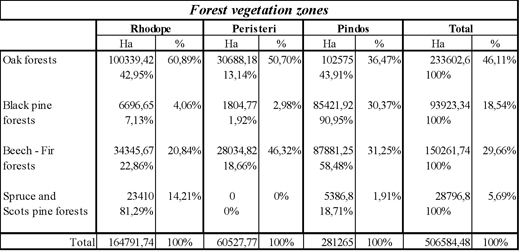
Recent results from telemetry studies showed that in Pindos nucleus, annual home ranges for 6 different bears, estimated by "minimum convex polygon" method, were: 206 km2 for a sub-adult male and 483 km2 for an old male. For two adult males the home range was 312 km2 and 507 km2, respectively, extending also on Albanian territory. For a third adult male, who is still monitored, autumn home range was 102 Km2. For a female bear, only the summer home range was calculated up to 13 km2. Seasonal home range for all bears showed highest values during fall (maximum 373 km2 estimated for the old male). Partial and spatial overlapping of home ranges occurred for all bears.
In Rhodope nucleus, the total home range size of a family group was 411 Km2. Autumn and early winter home range sizes, of the "family group", was larger (280 km2) than the one after separation from her cubs (59 km2).
Conflicts with humans:
Damages to livestock
Level of damage caused by the species to livestock is shown in the following table:

* Data from Hellenic Farmers' Insurance Organization (ELGA), processing: Spyros Psaroudas, M.Sc.)
Compensation system:
According to national law amendment in 1990, the National Organization for Agricultural Insurance compensates 100% of bear damage on livestock and beehives (only swarms). In 1997 and after a long period of pressure from ARCTUROS NGO, the national compensation system was improved to compensate 100% bear damage on crops, orchards, beehive boxes and younger cattle.
Preventive measures used.
The preventive measures used to avoid bear-human conflicts consist of two types: electric fencing of beehives and use of traditional shepherd dogs.
Human population density
Human population density distribution within the bear range is showed in the following diagram.
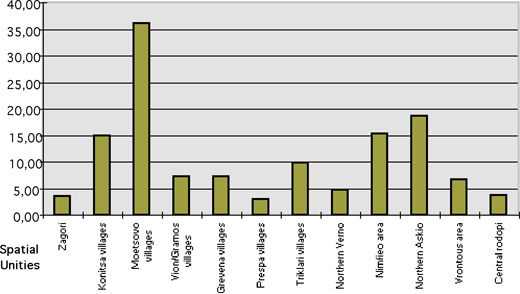
Distribution of livestock within bear range
Distribution of livestock within bear range is given by the following diagram:
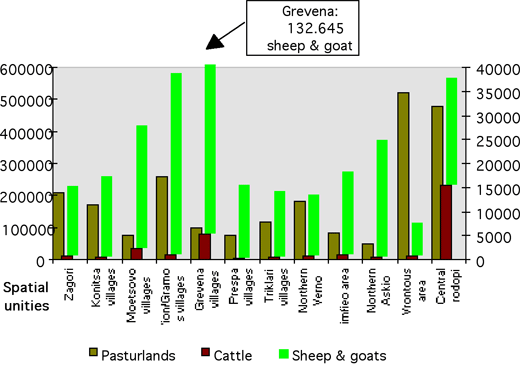
Legislation
The brown bear is a fully protected (priority) species under National law (86/69, article 258) and according the harmonization of E.C. Directive 92/43 to the Hellenic legislation.
Threats
Human caused mortality (animals killed per year - for figures see “mortality” at paragraph III – “population status”, above).
- Resentful farmers for bear damage caused on livestock and crops (use of fire-guns, illegal use of poison).
Habitat degradation and fragmentation by
- Highways and other infrastructure construction.
- Forest fires
Lack of information and/or negative attitude of specific target groups (e.g. hunters).
Conservation actions
A. National Action Plans.
A.1 National Level: A Bear Action Plan was produced after completion of the first LIFE-Nature project in Greece (1996).
A.2 International Level: A national action plan was established and improved by National Authorities and the Council of Europe in the frame of the Pan-European Action Plan for large carnivores (2000).
B. Conservation projects: Two LIFE –Nature Projects for conservation of brown bear and its habitats were completed. Another LIFE-Nature project is currently (2000-2002) implemented in areas of Rhodope and Gramos, including relevant brown bear conservation actions.
(Sources of the above data are mainly: LIFE93NAT/GR/010800, LIFE96NAT/GR/03222, LIFE99NAT/GR/06498 projects, Mertzanis (1992), Mertzanis et al. 1994.).




